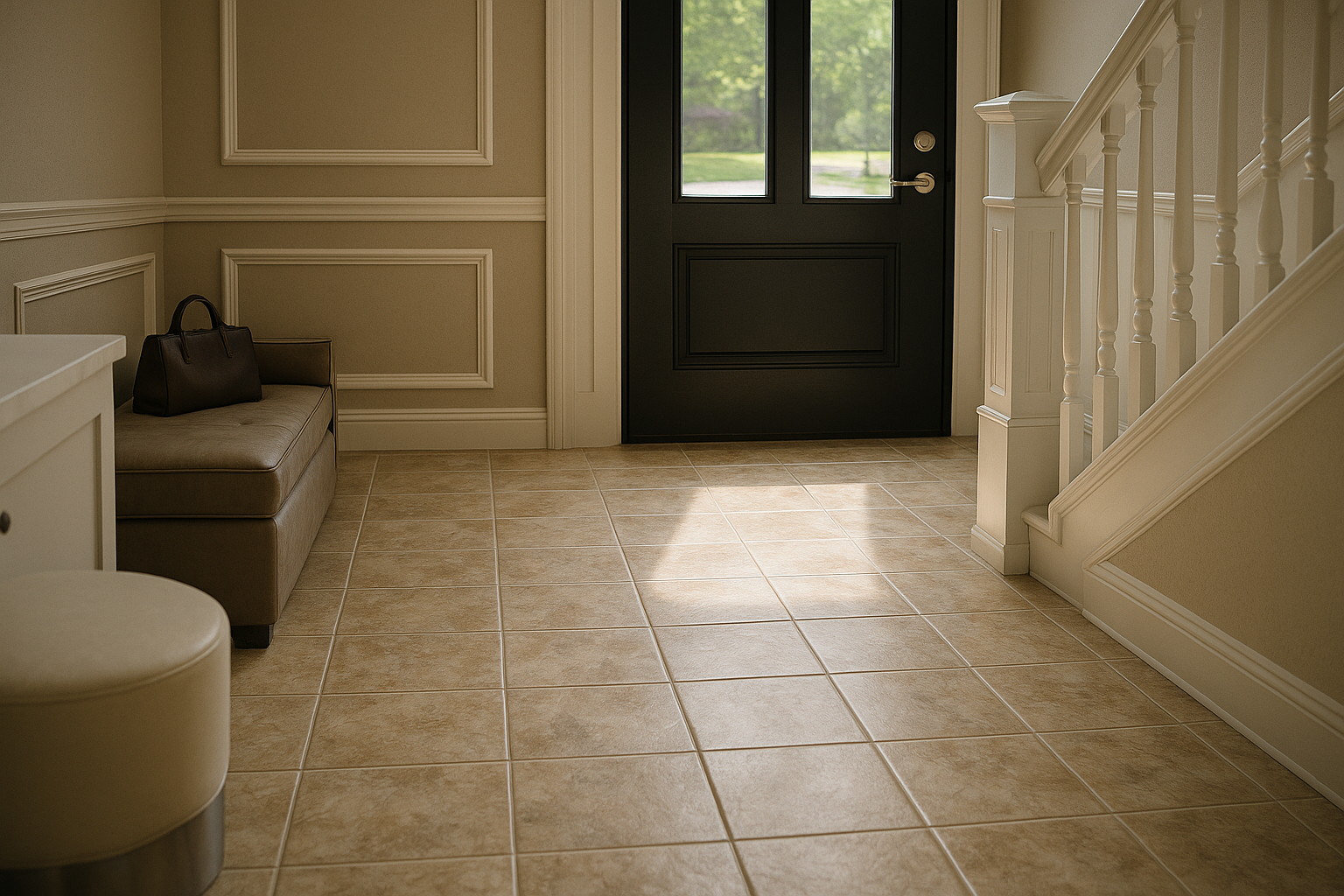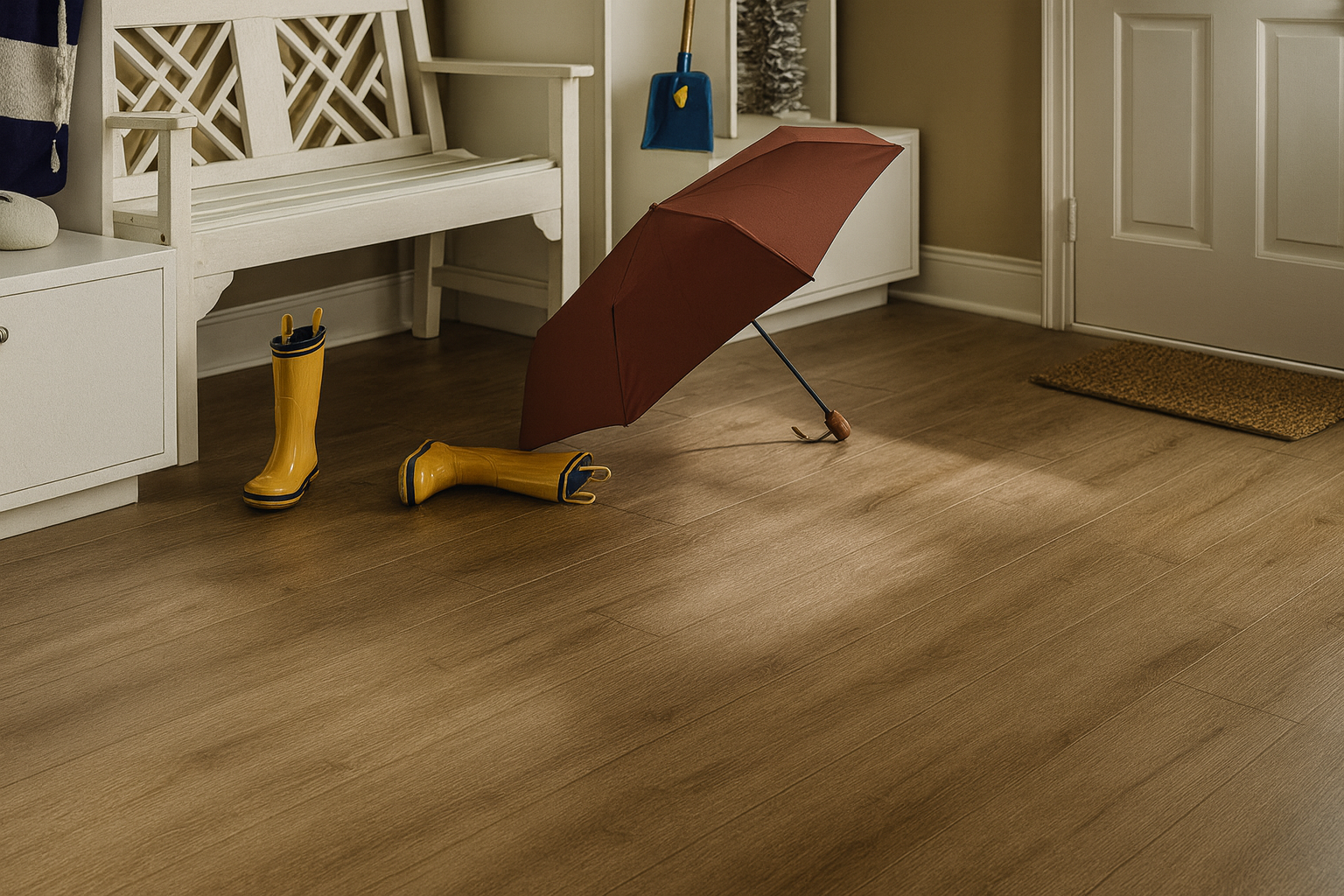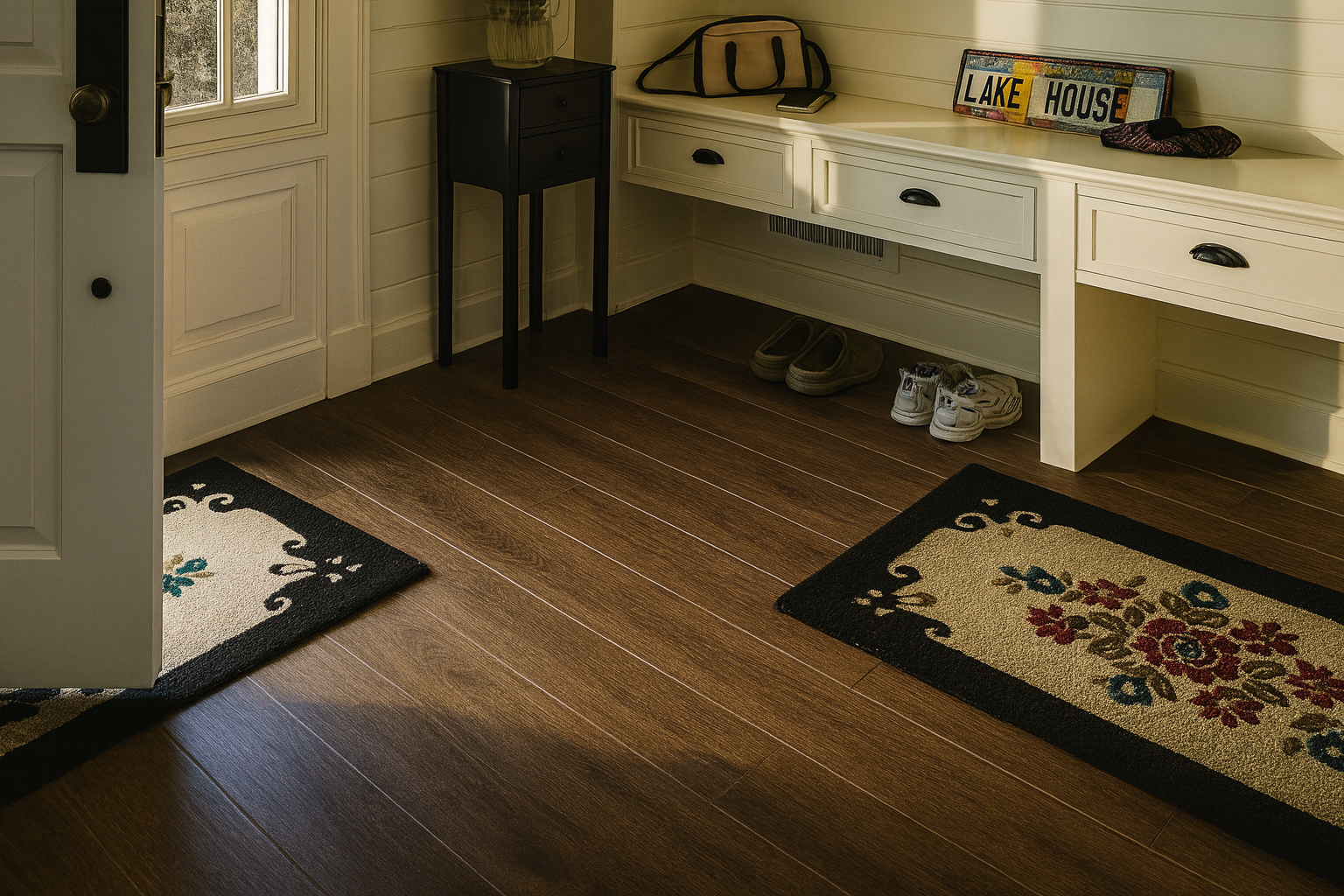Mudrooms take a beating – muddy boots, dripping umbrellas, pets charging in from the yard.
That means the floor you put down here has to do more than just look nice; it has to handle water, dirt, and constant traffic without giving in.
We’ll look at the best flooring for mudroom use, what each option does well (and not so well), and how to choose the right fit for your home.
Our Top 3 Picks
1. Porcelain & Ceramic Tiles
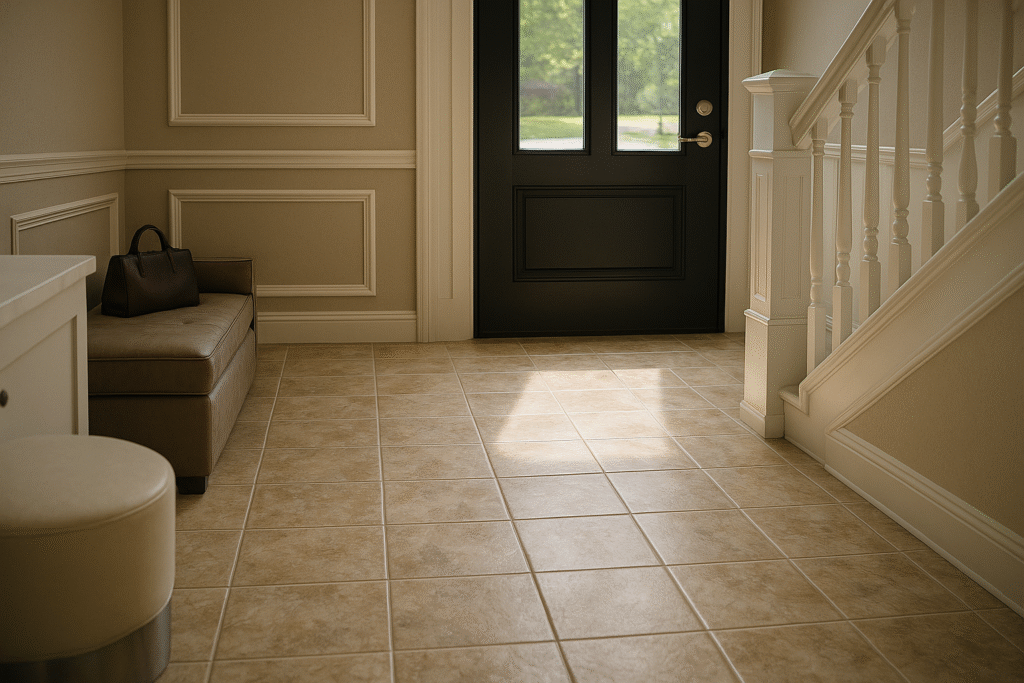
When it comes to mudrooms, tile is a classic for a reason.
Porcelain and ceramic tiles both stand up well to wet boots, muddy paw prints, and constant foot traffic. They’re easy to wipe down, resistant to water, and come in just about every style you can imagine – from clean neutrals to bold patterned designs.
Porcelain is the tougher of the two, built to handle high moisture and heavy wear, even in unheated mudrooms. Ceramic, on the other hand, is more budget-friendly while still offering plenty of style and functionality, though it needs a bit more care with moisture management.
Features
- Water-resistant surface (porcelain is nearly waterproof)
- Highly durable, with porcelain being denser and harder
- Wide variety of colors, styles, and finishes
- Low maintenance and easy to clean
- Cold and hard underfoot (can be paired with radiant heating)
Pros – Porcelain
- Superior water resistance
- Exceptional durability in high-traffic areas
- Sophisticated looks, can mimic stone or wood
- Great for unheated mudrooms
Cons – Porcelain
- Higher cost than ceramic
- More difficult and expensive to install
- Feels cold without heating or rugs
Pros – Ceramic
- Affordable and widely available
- Huge variety of colors and patterns
- Easy to clean and maintain
- Cost-effective choice for heated mudrooms
Cons – Ceramic
- Less durable than porcelain
- Can absorb water if unglazed
- Not recommended for unheated mudrooms
- Also feels cold and hard underfoot
2. Luxury Vinyl Plank (LVP)
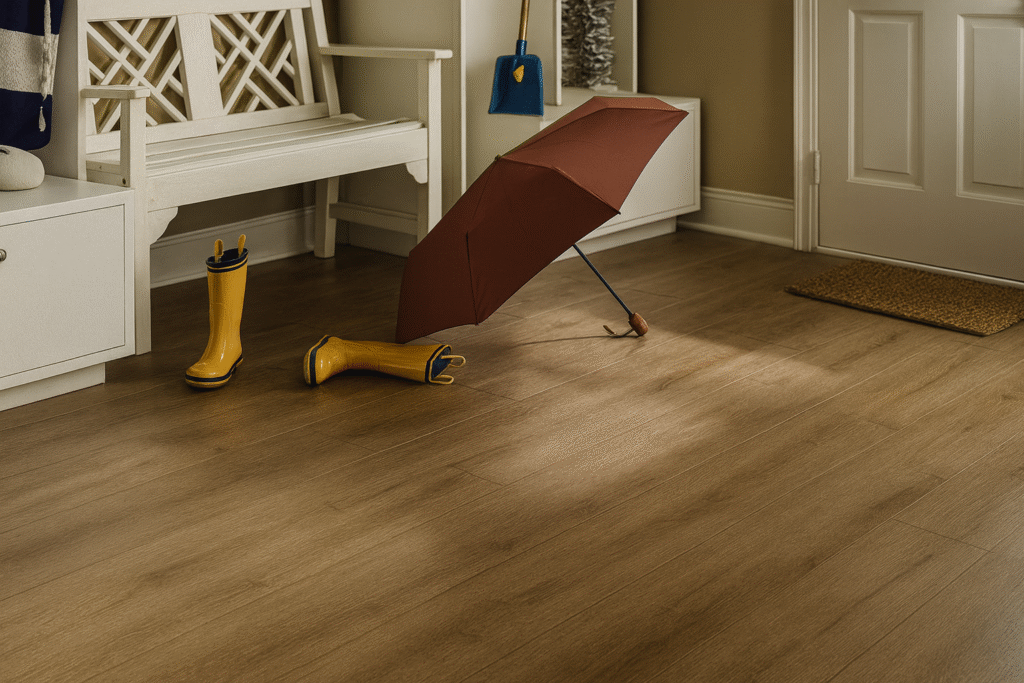
If you want the look of hardwood without worrying about muddy boots or wet paws ruining it, LVP is a strong contender.
Luxury Vinyl Plank is built with multiple layers that make it waterproof, durable, and surprisingly comfortable underfoot. It’s designed to handle all the mess and movement that comes with a mudroom while still delivering the warm, stylish appearance of natural wood.
Features
- Fully waterproof construction
- Multi-layer design for strength and comfort
- Realistic wood grain textures and finishes
- Scratch- and stain-resistant wear layer
- Easy to clean with simple maintenance
- Works with underfloor heating
Pros
- Excellent moisture resistance for wet, muddy conditions
- Durable against scratches, dents, and heavy use
- More affordable than hardwood or stone
- Comfortable underfoot with a bit of cushioning
- Stylish, wood-like look that blends with interiors
Cons
- Can scratch or dent with heavy furniture or sharp objects
- Not as long-lasting as natural hardwood or stone
- Some products may emit VOCs – low-VOC options are best
- Damaged planks may need replacing over time
- DIY installation possible, but tricky on uneven subfloors
3. Water-Resistant Laminate Flooring
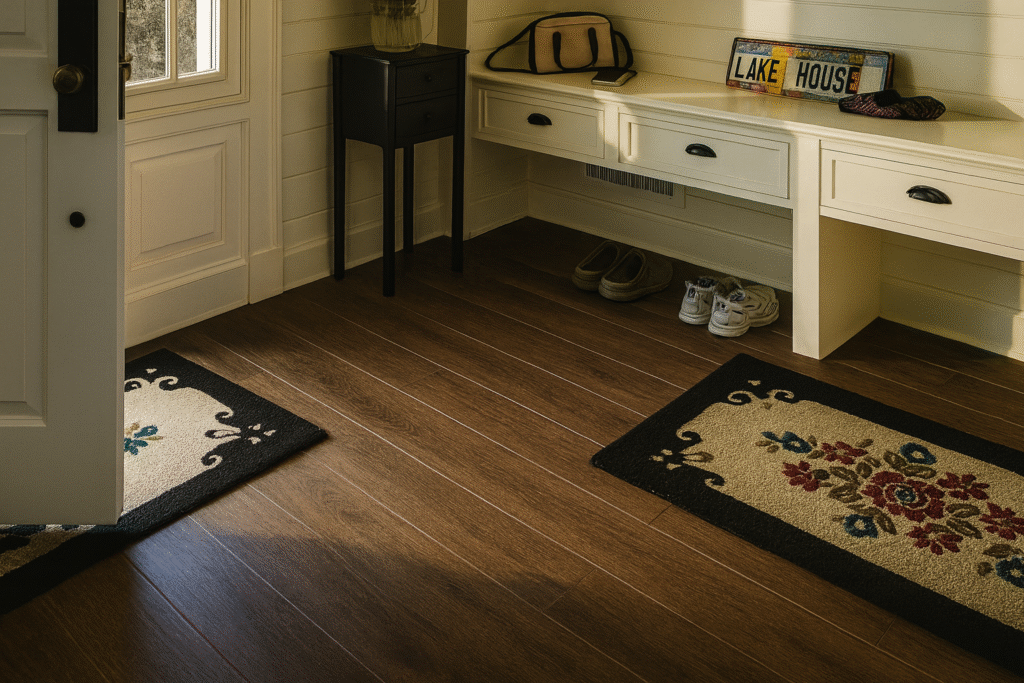
Laminate has long been a go-to for budget-conscious homeowners, and the water-resistant variety makes it more practical for mudrooms.
With a protective surface treatment and dense core, this flooring can handle splashes, wet shoes, and muddy paw prints – as long as spills don’t sit for too long.
It gives you the look of wood or stone at a fraction of the cost, while still standing up to daily wear and tear in high-traffic areas.
Features
- High-density fiberboard core with protective water-repellent surface
- Resists moisture for 24–48 hours if cleaned up promptly
- Wide variety of wood, stone, and tile-look finishes
- Click-lock installation system, often DIY-friendly
- Durable surface coating against scratches and dents
Pros
- More affordable than waterproof flooring
- DIY installation is easier compared to tile or stone
- Holds up against everyday splashes and humidity
- Wide style options to match mudroom décor
- Scratch- and dent-resistant for heavy traffic areas
Cons
- Not fully waterproof – standing water can cause swelling or warping
- Less durable in very wet or humid mudrooms
- Damaged planks can’t be refinished, only replaced
- Requires prompt cleanup of spills to avoid damage
- May need transition strips, which can break up the look
4. Concrete Flooring
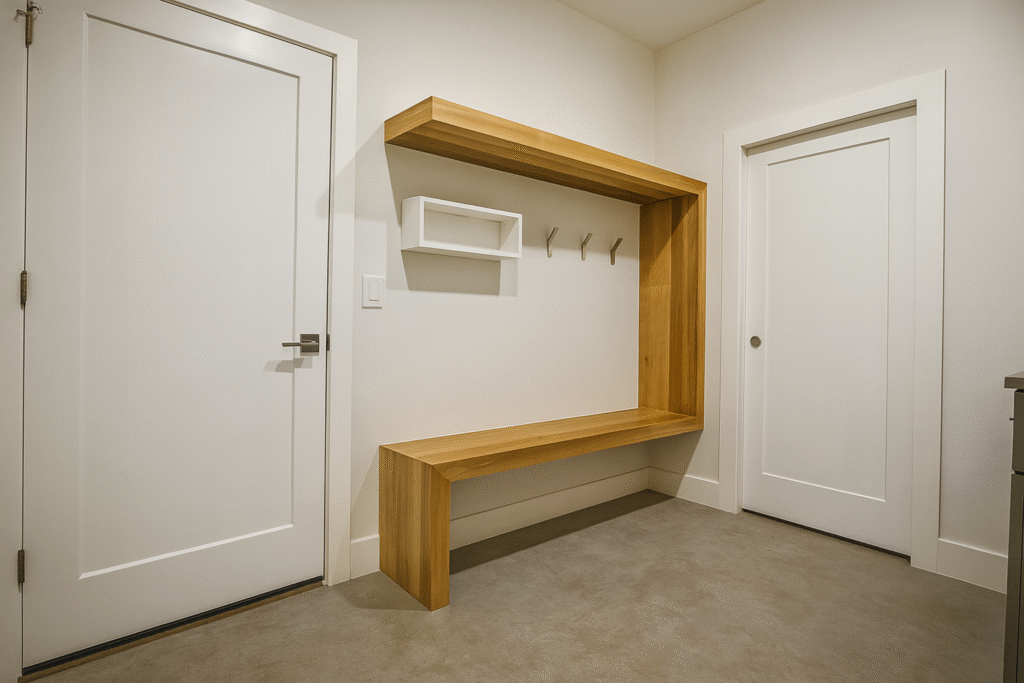
Concrete might not be the first material you think of for a mudroom, but it’s one of the most durable and practical options out there.
It can handle just about anything – muddy boots, dripping raincoats, or pets charging in from the yard. With finishes like polished, stained, or textured, concrete can be surprisingly stylish while keeping upkeep to a minimum.
Features
- Extremely durable, handles heavy traffic and moisture with ease
- Low maintenance; only needs cleaning and occasional sealing
- Customizable with staining, polishing, or textured finishes
- Fire-, stain-, and bacteria-resistant
- Compatible with radiant floor heating
- High thermal mass for moderating temperatures
Pros
- Long-lasting – can last for decades with proper care
- Easy to clean, low maintenance
- Customizable appearance for a unique look
- Sustainable and eco-friendly material
- Works well with radiant heating to offset coldness
- Cost-effective over the long term
Cons
- Hard surface, uncomfortable for standing long periods
- Feels cold underfoot without rugs or heating
- Can crack if not installed and sealed correctly
- Slippery when wet unless textured or treated
- Higher upfront installation costs with decorative finishes
- Longer curing time compared to other options
5. Natural Stone Tile
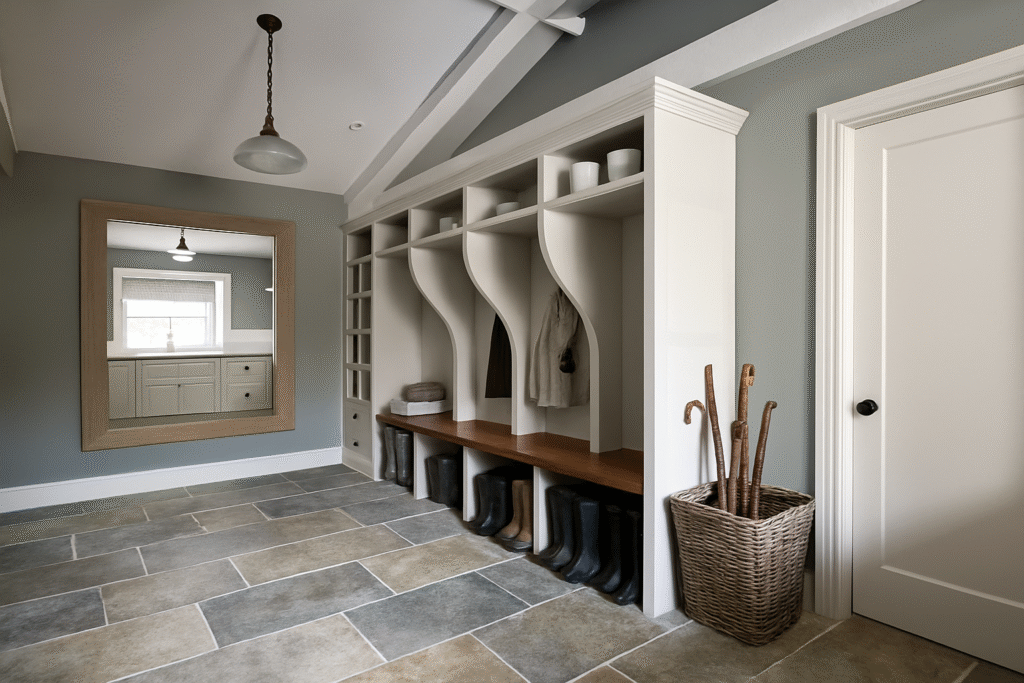
For homeowners who want a mudroom floor that feels both rugged and refined, natural stone tile is hard to beat.
Options like slate, granite, and quartzite can take on heavy foot traffic, muddy boots, and dripping umbrellas – all while adding a timeless, earthy beauty that elevates the space.
Every piece of stone is unique, so no two mudrooms look exactly alike.
Features
- Cut from real stone (granite, slate, travertine, limestone, etc.)
- Highly durable, resists cracking and impact
- Naturally varied patterns, textures, and colors
- Compatible with underfloor heating
- Textured stones (like slate) improve slip resistance
- Available in larger tiles for fewer grout lines
Pros
- Extremely durable and long-lasting
- Resistant to moisture and stains when sealed properly
- Unique, natural look – every installation is one-of-a-kind
- Works well with radiant floor heating
- Suitable for rugged, high-use conditions (mud, snow, pets)
Cons
- Requires sealing and resealing to prevent stains and water absorption
- Higher upfront cost than many alternatives
- Feels cold and hard underfoot without heating or rugs
- Polished stone can be slippery; textured finishes are safer
- Installation is labor-intensive and best handled by professionals
Comparison: Best Flooring for Mudrooms
| Feature | Porcelain & Ceramic Tile | Luxury Vinyl Plank (LVP) | Water Resistant Laminate | Concrete | Natural Stone Tile |
|---|---|---|---|---|---|
| Fully waterproof (handles standing water) | ✔️ | ✔️ | ❌ | ❌ | ❌ |
| High-traffic durability | ✔️ | ✔️ | ✔️ | ✔️ | ✔️ |
| Ready for unheated mudrooms | ❌ | ✔️ | ❌ | ✔️ | ✔️ |
| Slip-resistant when wet (typical finish) | ✔️ | ✔️ | ❌ | ❌ | ✔️ |
| Comfortable underfoot | ❌ | ✔️ | ✔️ | ❌ | ❌ |
| Works with radiant floor heating | ✔️ | ✔️ | ✔️ | ✔️ | ✔️ |
| Low maintenance day-to-day | ✔️ | ✔️ | ✔️ | ✔️ | ❌ |
| Budget-friendly | ✔️ | ✔️ | ✔️ | ❌ | ❌ |
| DIY-friendly install | ❌ | ✔️ | ✔️ | ❌ | ❌ |
| Wide style variety | ✔️ | ✔️ | ✔️ | ✔️ | ✔️ |
| Scratch and dent resistance | ✔️ | ✔️ | ✔️ | ✔️ | ✔️ |
| Needs periodic sealing | ✔️ | ❌ | ❌ | ✔️ | ✔️ |
| Grout to maintain | ✔️ | ❌ | ❌ | ❌ | ✔️ |
How to Choose the Best Flooring for a Mudroom
Selecting mudroom flooring is all about finding a surface that stands up to constant wear, wet conditions, and dirt while still fitting your home’s style.
Here are the main factors to weigh when deciding:
Durability
Mudrooms take a beating from boots, sports gear, and pets. You need flooring that resists scratches, dents, and impact.
- Best: Concrete and natural stone lead here, lasting for decades with minimal wear. Porcelain tile also holds up extremely well under heavy use.
- Less Good: Water-resistant laminate is durable for everyday traffic but can’t match the toughness of stone or tile if abused.
Moisture Resistance
Moisture is unavoidable in a mudroom, so water protection is critical to avoid warping, swelling, or mold.
- Best: Porcelain tile and LVP are the most reliable for standing water. Natural stone works well if properly sealed.
- Less Good: Ceramic tile is fine for light exposure but not ideal in unheated mudrooms, while water-resistant laminate only protects against short-term spills.
Ease of Maintenance
Mudrooms get messy, so floors should be quick to clean and stain-resistant.
- Best: LVP and porcelain/ceramic tiles are easy to mop and wipe down. Concrete is also low effort once sealed.
- Less Good: Natural stone requires resealing and pH-neutral cleaners, which adds maintenance over time.
Slip Resistance
Safety is a must in a wet, high-traffic space. Textured finishes help prevent accidents.
- Best: Slate and textured porcelain or ceramic offer solid traction. LVP usually has a softer, less slippery surface.
- Less Good: Polished stone and glossy tiles can be slick when wet unless treated or paired with mats.
Aesthetic Integration
Mudrooms connect indoors and outdoors, so style matters.
- Best: LVP and water-resistant laminate provide warm wood looks without the risk of real hardwood. Natural stone creates a rustic, high-end feel, while tile offers endless design versatility.
- Less Good: Concrete has design potential but requires finishing to avoid feeling industrial or cold.
Longevity and Value
The right choice balances upfront cost with long-term resilience.
- Best: Porcelain, concrete, and natural stone are investments that can last decades.
- Less Good: Laminate is more affordable but won’t last as long, especially in wet environments.
Bottom Line:
For all-around performance, porcelain tile and LVP are standout choices.
Stone and concrete deliver unmatched longevity and toughness but demand more investment and upkeep.
Laminate works if budget is top priority, but it needs more care around moisture.
Frequently Asked Questions
Can I use hardwood flooring in a mudroom?
Solid hardwood isn’t recommended for mudrooms since it swells and warps when exposed to moisture. Engineered hardwood is more stable, but tile, vinyl, or stone are usually better choices.
Do mudroom floors need underfloor heating?
Not necessarily, but it can make cold materials like tile, stone, or concrete much more comfortable underfoot. Heating also helps dry out moisture faster.
What’s the best flooring for homes with pets in the mudroom?
Luxury Vinyl Plank (LVP) and porcelain tile are top picks because they resist scratches, moisture, and mud from paws. They’re also easy to wipe clean.
How often should mudroom flooring be resealed?
Concrete and natural stone need sealing every few years (stone every 5–10, concrete more frequently depending on use). Tile usually only requires resealing the grout.
Conclusion
Mudrooms ask more from flooring than almost any other part of the house. They’re the first stop after rain, snow, or a day in the yard, which means water, dirt, and heavy traffic are a given.
That’s why the best flooring for mudroom use isn’t about looks alone, but about materials that hold up when things get messy.
Tile and stone give unmatched durability, LVP offers comfort and waterproof strength, laminate balances cost with practicality, and concrete brings long-term toughness with little upkeep.
Not sure which way to go? Book a free in-home appointment – we’ll bring samples to your door, walk you through pricing, and help you pick the option that fits your space best.


